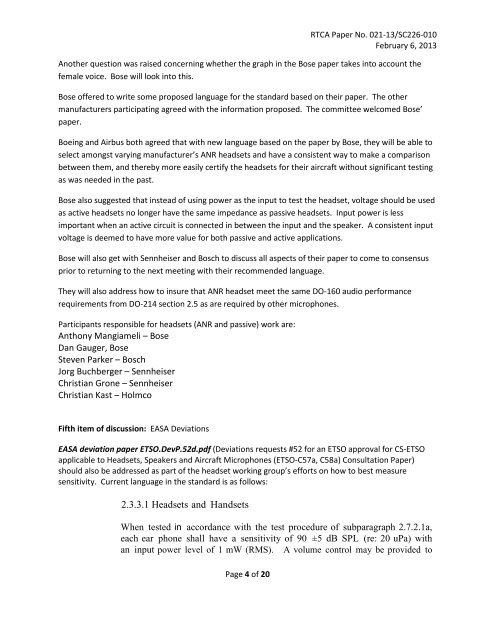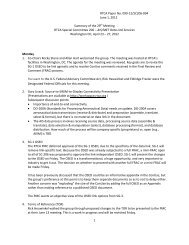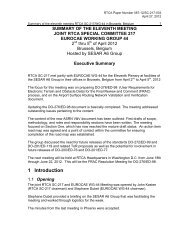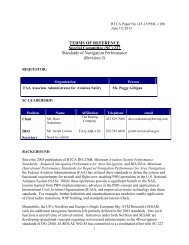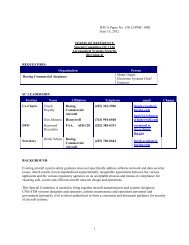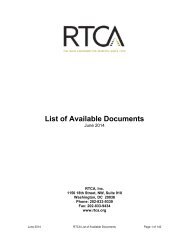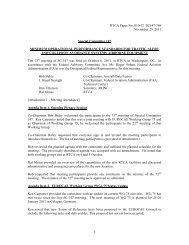SC-226 MEETING MINUTES Working Group JANUARY 14 ... - RTCA
SC-226 MEETING MINUTES Working Group JANUARY 14 ... - RTCA
SC-226 MEETING MINUTES Working Group JANUARY 14 ... - RTCA
Create successful ePaper yourself
Turn your PDF publications into a flip-book with our unique Google optimized e-Paper software.
<strong>RTCA</strong> Paper No. 021-13/<strong>SC</strong><strong>226</strong>-010<br />
February 6, 2013<br />
Another question was raised concerning whether the graph in the Bose paper takes into account the<br />
female voice. Bose will look into this.<br />
Bose offered to write some proposed language for the standard based on their paper. The other<br />
manufacturers participating agreed with the information proposed. The committee welcomed Bose’<br />
paper.<br />
Boeing and Airbus both agreed that with new language based on the paper by Bose, they will be able to<br />
select amongst varying manufacturer’s ANR headsets and have a consistent way to make a comparison<br />
between them, and thereby more easily certify the headsets for their aircraft without significant testing<br />
as was needed in the past.<br />
Bose also suggested that instead of using power as the input to test the headset, voltage should be used<br />
as active headsets no longer have the same impedance as passive headsets. Input power is less<br />
important when an active circuit is connected in between the input and the speaker. A consistent input<br />
voltage is deemed to have more value for both passive and active applications.<br />
Bose will also get with Sennheiser and Bosch to discuss all aspects of their paper to come to consensus<br />
prior to returning to the next meeting with their recommended language.<br />
They will also address how to insure that ANR headset meet the same DO-160 audio performance<br />
requirements from DO-2<strong>14</strong> section 2.5 as are required by other microphones.<br />
Participants responsible for headsets (ANR and passive) work are:<br />
Anthony Mangiameli – Bose<br />
Dan Gauger, Bose<br />
Steven Parker – Bosch<br />
Jorg Buchberger – Sennheiser<br />
Christian Grone – Sennheiser<br />
Christian Kast – Holmco<br />
Fifth item of discussion: EASA Deviations<br />
EASA deviation paper ETSO.DevP.52d.pdf (Deviations requests #52 for an ETSO approval for CS-ETSO<br />
applicable to Headsets, Speakers and Aircraft Microphones (ETSO-C57a, C58a) Consultation Paper)<br />
should also be addressed as part of the headset working group’s efforts on how to best measure<br />
sensitivity. Current language in the standard is as follows:<br />
2.3.3.1 Headsets and Handsets<br />
When tested in accordance with the test procedure of subparagraph 2.7.2.1a,<br />
each ear phone shall have a sensitivity of 90 ±5 dB SPL (re: 20 uPa) with<br />
an input power level of 1 mW (RMS). A volume control may be provided to<br />
Page 4 of 20


